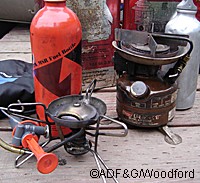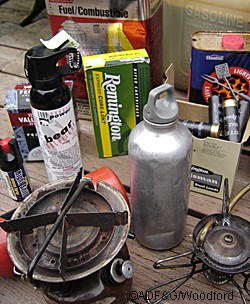Alaska Fish & Wildlife News
September 2006
Flying Camp Stoves
Camps Stoves Legal but Must be Super Clean

The camp stove is an essential piece of gear for hunters, backpackers, rafters – virtually anyone spending the night outdoors. But chances are good that a Transportation Safety Officer will confiscate your stove at the airport. It’s not illegal to fly with a stove, but it’s tricky.
Scott Rader, the camping department manager at REI in Anchorage, is quite familiar with the issue. He’s outfitted customers with new stoves because they’ve had theirs confiscated en route. He said travelers with stoves are finding the TSA to be “very subjective.”
“It’s pretty common to see stoves confiscated, “he said. “Some people have no problems, others are shocked to find their stoves confiscated at one leg of a trip. Some customers have come in for fuel bottles, because those were confiscated, but not the stoves.”
Andy Hunter with Alaska Mountaineering and Hiking in Anchorage said his customers report that some airlines will allow stoves if they are brand new and have never had fuel. He said he’s outfitted a few travelers with new stoves because they were unable to bring a stove into Alaska.
Camp stoves are legal, but the call is up to the TSA official at the airport. The TSA website says camp stoves can travel as carry-on or checked luggage only if they are empty of all fuel and cleaned so that there are no vapors or residue. Simply emptying the fuel container will leave flammable vapors. The TSA recommends that you ship the empty fuel containers to your destination ahead of time, and notes that passengers frequently have to leave them at the checkpoint because of fuel vapors.

“It really comes down to smell,” said TSA spokesperson Jennifer Peppin. “Does it smell like flammable material? If you can get it as clean as possible and free of gas odor, that’s going to help.”
She said it’s always better to check a questionable item, rather than try to carry it on. She said let the airline know what you’ve got, and the airline and the TSA will work with the passenger to resolve any questions about the item.
A camp stove such as the Coleman Peak 1 or the Svea 123, with attached fuel tanks, are going to be tough to transport. It would be very difficult to completely clean the stove, and the attached fuel tank is problematic. Other small camp stoves, such as stoves with removable propane canisters, or the MSR Whisperlite, are just burners with some hardware.
Alaska Airlines air cargo customer call center agent Cindy Gonzales said if all else fails, a stove can be shipped as cargo.
“Within the state there no special requirements,” she said. A stove is considered hazardous material, and there is a $50 hazardous material fee in addition to shipping costs for the item. Additional hazardous materials are $15 each, but they could all be combined in one package if practical.
After the trip, it may be best to mail the stove home. It must be clean, not smell of fuel, and properly packaged.
Subscribe to be notified about new issues
Receive a monthly notice about new issues and articles.
